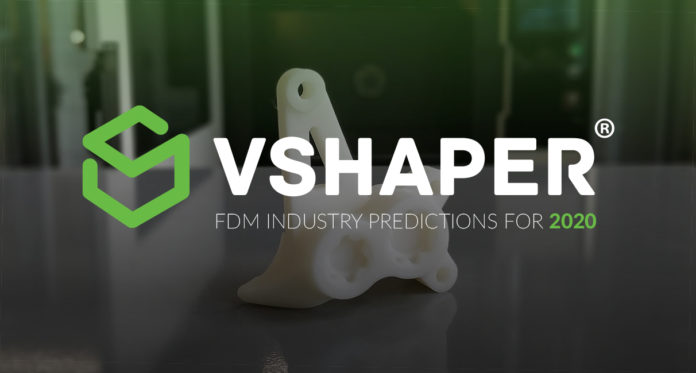Marcin Szymański, Product Director at VSHAPER, Polish manufacturer of FDM 3D Printers, shares the company’s predictions for the FDM 3D Printing segment in 2020. While the company is preparing the official launch of the VSHAPER 5AX, whose development has been announced two years ago, their engineers have been able to identify key areas to watch in terms of materials, size of printouts and printing nozzle.
“The 3D printer trade expands every year. Possibilities, which deliver the additive print technology with thermoplastic materials shaped for industry, astonish. The business is in continual development, and the need for the next innovations is increasing. The main idea of spreading the material layer by layer until the right shape is built may appear simple. While thinking of prototyping applications, it sure is, and there are no difficulties in this these days. The 3D print has entered into the high-end tools processes as a support for production lines, maintenance and service, and more and more often as an alternative to injection molding or cutting processes – for smaller series.
If we want to predict [how 3D printing will move forward] with thermoplastic materials – let’s start with today’s state and see how it will progress (within the margin of the next year).”
MATERIALS
The main criteria which define one’s industry is a material needed to make a product, but while saying of 3d print, the main criteria becomes the features of a particular substance.
The light materials like polymers known as nylons are reinforced with carbon fiber or cellulose – thanks to this, the printed detail has lightness and durability that can compare with an aluminum one. Slimming of systems consisted of metal parts by changing the material of which the single elements are made to a competitive one, heat, chemicals, and impact-resistant modern polymers like PEI, PEEK or PEKK became the constant direction, which will develop further.
The industry in which the 3D print with thermoplastic materials where the precise and personalized approach to detail is needed to develop is in the field of medical applications. Already biocompatible materials are used in bone grafts.
Work towards the development of materials of different features simultaneously accepted by the aggressive body environment and free from defects of previously used ones will undoubtedly be very advanced.
THE SIZE OF PRINTOUTS
Today the size of printed details is limited to the space of the 3d printer working chamber, which usually is small. The aerospace, military, automotive industries, or even boat producers are looking for alternative ways for production. The barrier is often the end size of a printed product and its final machining. Today, the first attempts of large printouts (of about a few meters high) have been made. For commercial purposes, these machines usually have open working chambers, which significantly limits the range of materials possible to use. There are several problems such as processing shrinkage, very long printing time or as mentioned above lack of control on thermal conditions in the print space, which additionally complicates the prediction of the final printout effect. On the other side, very high costs of production of this kind of elements with traditional ways cause the problems mentioned earlier don’t discourage machine producers from attempts and researches related to printing larger sized items.
PRINT PLANE RELEASE
Limiting the operation of the printing nozzle in traditional 3D printers to 3 axes results in a parallel plane of all layers, which due to the clearly anisotropic properties of prints, is an obvious limitation for printing technology using the deposition of plasticized thermoplastic material. It means that the printed detail may have adequate strength on one axis, but not on another. The phenomenon of the anisotropicness of the printout may be overcome by setting the proper position of models on the print surface. Unfortunately, for most models, just the placing of them is not enough to properly strengthen all geometry elements. This fact can have a significant impact on the possibility of using additive technologies in industry and also reduces their competitiveness in comparison with traditional methods of production, e.g., machining.
The approach to additive technology and printer construction is changing. The prediction of mechanical properties of multi-axis reinforced prints, as well as printing from several materials during one printing process will allow creating advanced geometries with mechanical properties tailored to the application. It is another milestone in the industrial use of 3D printing thermoplastic materials.
Remember, you can post free of charge job opportunities in the AM Industry on 3D ADEPT Media or look for a job via our job board. Make sure to follow us on our social networks and subscribe to our weekly newsletter : Facebook, Twitter, LinkedIn & Instagram ! If you want to be featured in the next issue of our digital magazine or if you hear a story that needs to be heard, make sure to send it to contact@3dadept.com.






